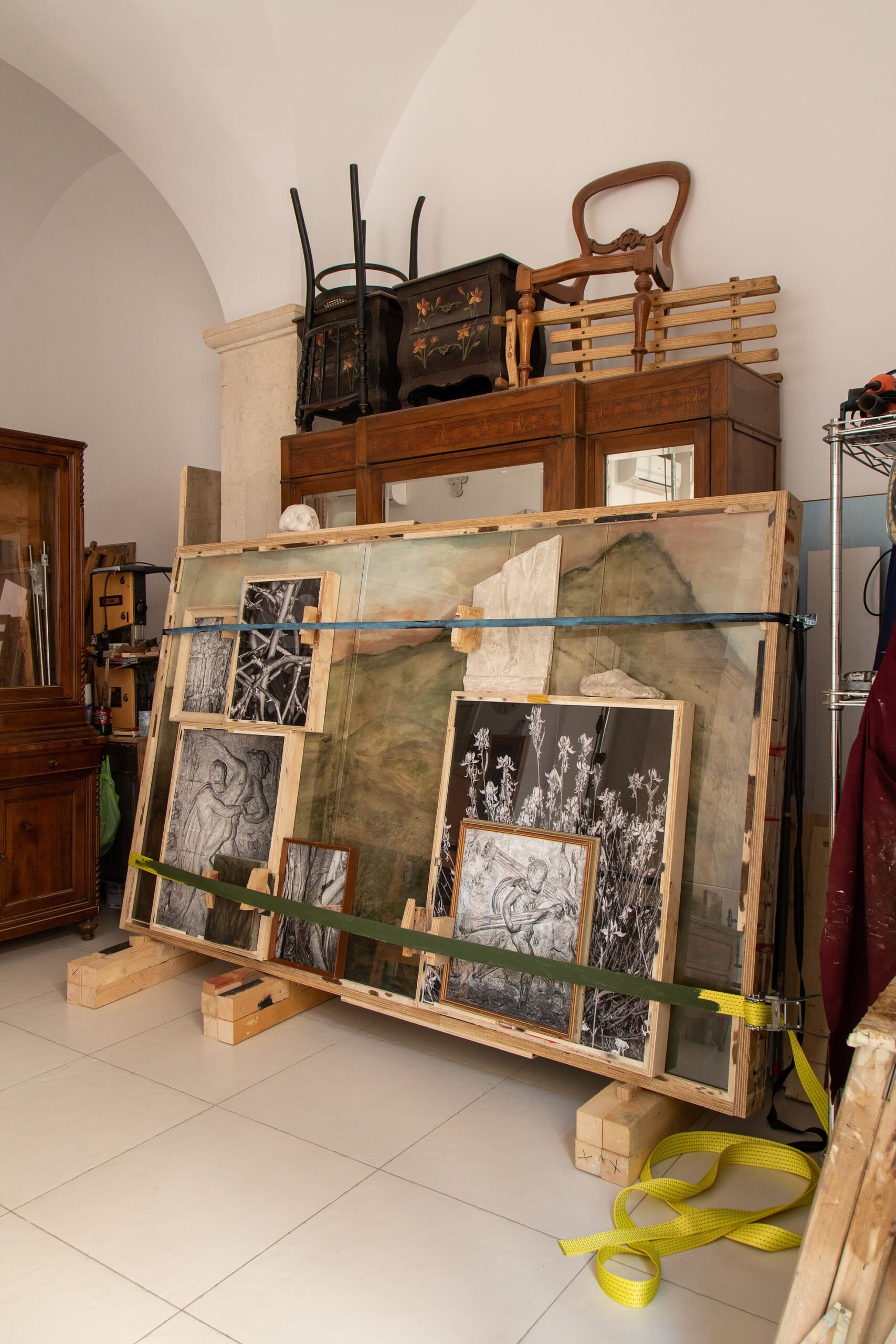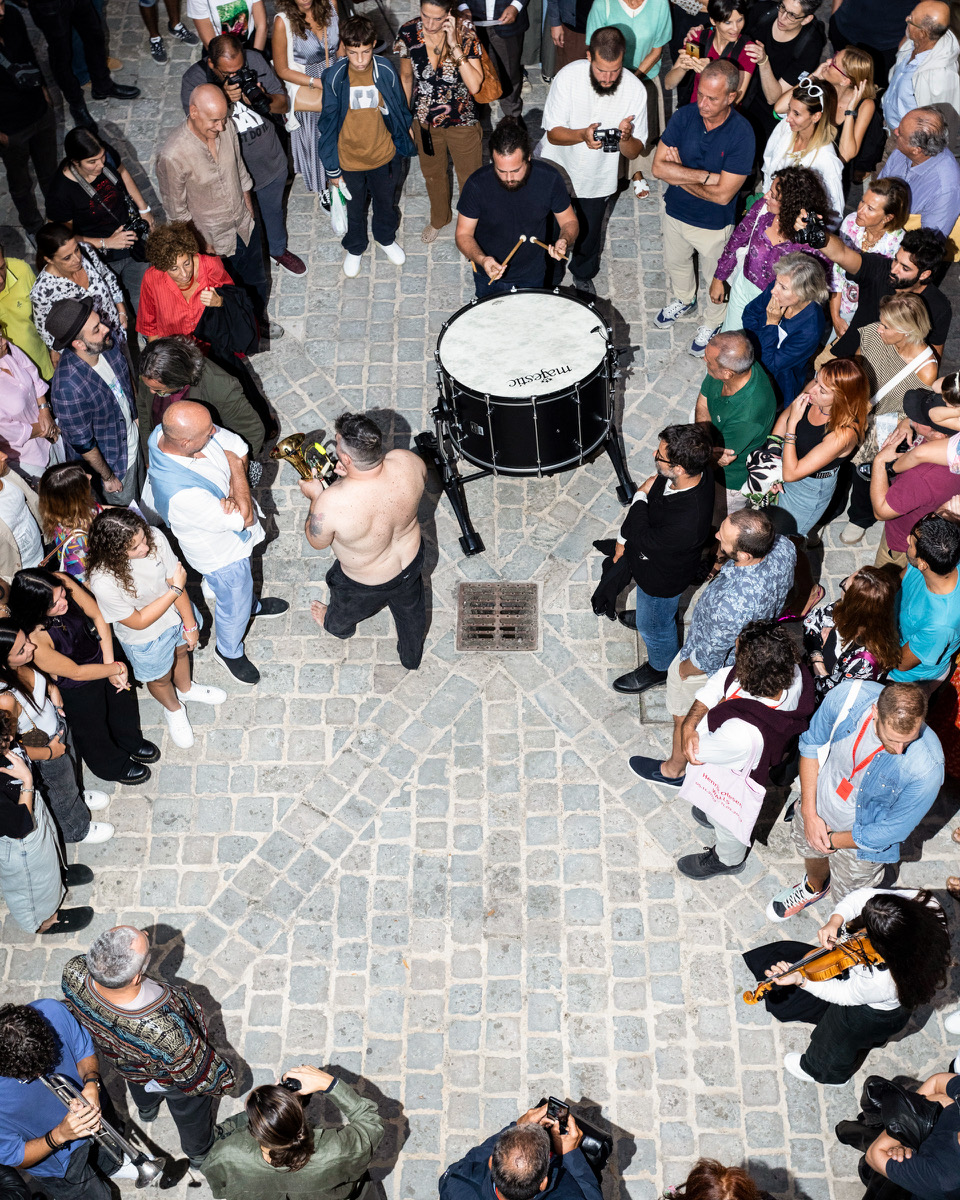Jacopo Benassi: Dealing with Nature as a Political Act
Jacopo Benassi
How did “Rivoluzione 2023,” the work you presented for the third edition of Panorama, the Italics initiative curated by Cristiana Perrella, come about?
The first time I came to L’Aquila, it was to perform, and I wasn’t aware of Italics. Then Cristiana Perrella (the curator of Panorama L’Aquila 2023) called me for a site visit. I returned here with her in early June when everything was still undecided. During this visit, I collected some material, and though I took very few photos, I found inspiration; those few photos I took of the brooms that populate L’Aquila were enough. In my works, the idea always starts with a painting. I wanted to work on L’Aquila as I have worked on my own city (La Spezia), starting from scratch, removing the city, and placing nature at the center, which continues to thrive even without us.
I don’t see the earthquake as a catastrophe but as a new beginning. Nature pushes us to start anew, to understand who we are. The straps that support the university are the same straps I’ve been using in my work for two years now. Finding them here was surprising. I saw unconscious works of art created by firefighters to secure buildings. So, the straps doubly strengthened the work, establishing a direct connection with the represented place: straps, fragile as glass but also strong because the work it’s heavy and massive. A painting representing Gran Sasso, so significant for Abruzzo and the people of L’Aquila; on top of the painting I’ve placed a layering of photos: brooms, flowers that always grow, like this city which has reborn and still lives; intertwined roses, flowers that prick and wound; a gypsum skull representing the passage of time and death; a photo of Hercules taken in Paris, the Hercules carrying the columns is a symbol of construction, resistance, strength, and strong person like those in this country.
L’Aquila is thus symbolically represented here as a place of death, wounds, and rebirth. This work is about connection, strength, and fragility. The straps that hold the work together represent strength, and the wooden blocks create tension in the straps, if they are removed, everything collapses. The work relies on this precarious element: the wood represents fragility, and the straps represent strength. I work between these two opposing poles of strength and fragility.

Why did you title this work “Rivoluzione! 2023” and why does the performance you created in collaboration with the conservatory students also bear the same title?
Because there is a revolution: a revolution driven by the climate, the terrain, the mountains, and nature. I’m an artist who hates to think, so it was straightforward. I created a symphonic situation that the students realized but that I managed. I met them for the first time the other day (two days before the performance). We rehearsed for only one day. I work a lot on the edge, and I love the aspect of improvisation. In fact, the performance is a work in progress and will never be the same. It starts symphonically, then the musicians gradually move toward my world, which is noise. They move in symbiosis with the cameras, which are my work but operated by others.
So there’s photography, confusion, changing sound. I asked the students not to produce melodic sounds. I play an unlettered trumpet. This is the revolution: “Illiterate Music” (musica analfabeta). It’s not a movement, but it’s a provocative title to claim that I’m not a musician. It started as a concert, turned into a performance, and emerged into melody. So, initial melody, revolution, final melody, all managed by me; here, I become the orchestra conductor. I make the musicians play or stop by touching them, and I engage with the audience, interacting with people and taking them by the arm. That’s why the performance has the same title, and it’s connected to the artwork because it brings back the theme of connection. In the performance, I love improvisation and the idea that I can change it as it unfolds. That’s my strength. My work lies in imperfection. The painting is like “illiterate music”. If I were to seek perfection, I would create horrible forms because I’ve realized that my work is based entirely on improvisation. I work by trying to be myself. Often, when a work is finished, it appears incomplete, poorly done, but it’s my work. You’re interviewing me at a moment when I’m understanding who I am. I’m a person who loses concentration. I no longer try to concentrate too much. I’ve realized that the more I let go, the better things turn out.

Panorama brings artists and gallerists to interact with an Italian village every year, not just with the space but also with the people. How was it working with the conservatory students?
When we went to talk to the conservatory professors with Cristiana Perrella, I was very tense. I feared that talking to musicians about “illiterate music” would be incomprehensible to them. But the response they gave me was that “illiterate music” is still music, it’s sound. However, I believe that this is a disruptive concept. I didn’t want to do a concert with the students; I wanted to bring them into my world of contemporary art. In my opinion, conservatories should offer courses on contemporary art because they would give young people the opportunity to broaden their horizons. The students enthusiastically embraced the project; they were happy, almost moved. My performances depend on the audience; the audience is always an integral part. For six minutes tonight, the audience was the “broken score”: a reference to Giuseppe Chiari, Dadaism, Fluxus.
In L’Aquila you had the opportunity to meet Paolo Icaro. How was your encounter with him?
It was wonderful; I could spend a whole lifetime with that man. I didn’t expect it, but Alessandra Minini called me and said, “Come here, Icaro wants to meet you.” I rushed to meet him, and it was love at first sight. I said, “I’m honored,” and he told me, “Don’t bullshit, save that for someone else; that’s enough.” It was a beautiful exchange. Icaro came to see my work when the journalists were present, and he said a beautiful phrase about sound: I saw him touching the straps of the painting… the tension of the straps and the wood reminded him of music as if they were elements of an instrument: “by touching these straps, notes come out to be inserted into the score of this painting.” He referred to the sound of my work… and I was moved.
Is there anything in particular you liked about this edition of Panorama?
I saw very little, but I liked Luisa Lambri’s work at Palazzo Rivera. She worked on Pompei, and some of my works are also inspired by Pompeii. I paint very quickly; I’ve realized I have to paint like I photograph. I can’t do a job that takes ten days. I completed the work on Pompei in a day and a half: erasing, scratching, applying bitumen, aging it… For me, it’s as if the work went through the same process as Pompeii. I didn’t start as a painter, but my relationship with the canvas has changed my life; it’s beautiful.
Often in your works there are elements that are covered or erased. Why is that?
“Rivoluzione! 2023” has elements I love, but I covered some of them because I believe sacrifice is necessary. I like it when the audience wonders what’s behind it when they question the hidden sides of my work. In my recent works, I even turn my photos, and self-portraits of myself, which are printed, forcing the observer to think about and wonder what’s behind the rotated image and why I decided not to show it. We are bombarded with images, so in this case, censorship is a search for emptiness to leave room for imagination. Then, I like the idea of renunciation. I give up a lot in my work; when I take photographs, I always leave without having the perfect photo. I always feel like a photojournalist; I wonder what it means to take a photograph. What does it mean to have your photo taken? Whose photo is it, the one who takes it with my camera? A human tripod? This is an interesting debate, and the controversy is still open. Do the photos of the performance become works of art? For me, not entirely, or maybe partly, sometimes.
Can you tell us about your relationship with nature, which has recently become the focus of your paintings?
Wild nature and even cultivated nature have taken center stage in my recent works. For some time now, I’ve been dedicating the same attention to nature as I used to give to portraits, although I don’t think I’ll return to portraits now. Not even to those people I used to want to include in my human archive, like footballers, musicians, and writers whom I used to photograph for magazines. I wanted to change subjects for a long time, and I had started experimenting with nature, but I couldn’t find the way. In my artworks, I no longer create portraits; instead, I seek nature, which no longer needs us. Nature goes on, and I think environmentalism is the new humanism. In my paintings, I never include houses, boats… I never include anything human, only water, earth, grass, plants, rocks, flowers… Nature is a new beginning. When they say artists don’t engage in politics, they’re wrong. Dealing with nature, for me, is a political act to reset the world, to start again.




